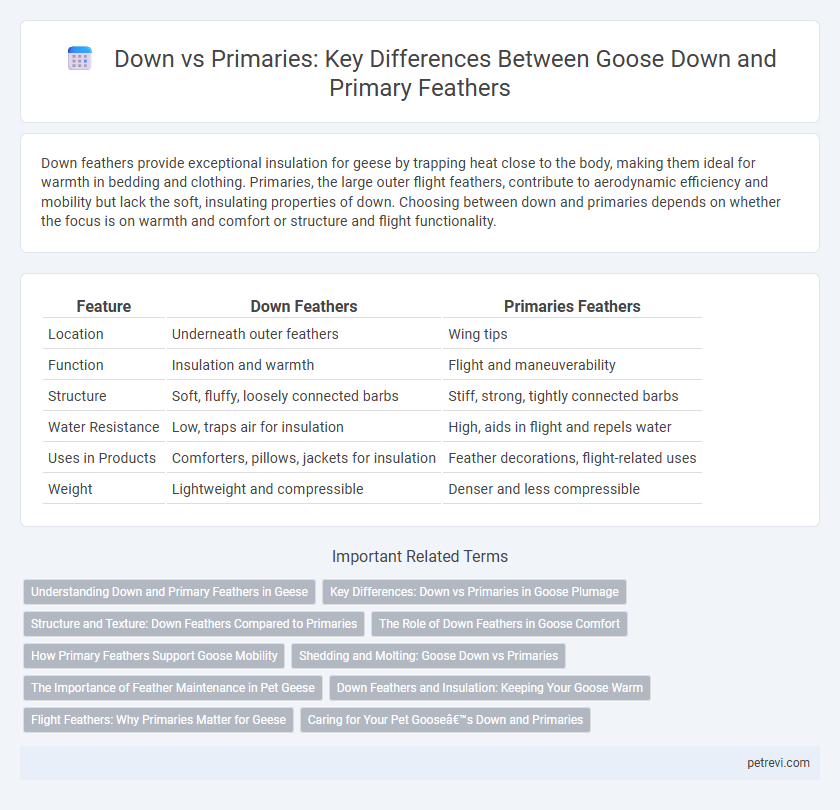Down feathers provide exceptional insulation for geese by trapping heat close to the body, making them ideal for warmth in bedding and clothing. Primaries, the large outer flight feathers, contribute to aerodynamic efficiency and mobility but lack the soft, insulating properties of down. Choosing between down and primaries depends on whether the focus is on warmth and comfort or structure and flight functionality.
Table of Comparison
| Feature | Down Feathers | Primaries Feathers |
|---|---|---|
| Location | Underneath outer feathers | Wing tips |
| Function | Insulation and warmth | Flight and maneuverability |
| Structure | Soft, fluffy, loosely connected barbs | Stiff, strong, tightly connected barbs |
| Water Resistance | Low, traps air for insulation | High, aids in flight and repels water |
| Uses in Products | Comforters, pillows, jackets for insulation | Feather decorations, flight-related uses |
| Weight | Lightweight and compressible | Denser and less compressible |
Understanding Down and Primary Feathers in Geese
Goose feathers consist primarily of down and primary feathers, each serving distinct functions essential for the bird's survival and insulation. Down feathers, located beneath the outer feathers, are soft and fine, providing exceptional thermal insulation by trapping heat close to the body. Primary feathers, found on the wings, are stiff and strong, facilitating flight by generating lift and enabling maneuverability.
Key Differences: Down vs Primaries in Goose Plumage
Goose down feathers are soft, fluffy clusters found beneath the outer layer, providing exceptional insulation due to their ability to trap air and retain heat. Primaries are the long, stiff feathers located on the wings, essential for flight, durability, and aerodynamic function. While down excels in warmth and softness, primaries contribute to mobility and protection, highlighting their distinct roles in goose plumage.
Structure and Texture: Down Feathers Compared to Primaries
Goose down feathers have a soft, fluffy structure with fine barbs that create a lofty, insulating layer ideal for trapping heat. In contrast, primary feathers are long, stiff, and streamlined, designed for flight and providing lift and aerodynamics. The texture of down is delicate and compressible, while primaries have a smooth, firm surface to reduce air resistance.
The Role of Down Feathers in Goose Comfort
Down feathers provide superior insulation by trapping air close to a goose's body, ensuring optimal warmth and comfort in cold environments. Primaries, while essential for flight and protection, do not offer the same softness or thermal properties as down. The unique structure of down clusters enhances buoyancy and moisture resistance, making them crucial for maintaining body heat during harsh weather.
How Primary Feathers Support Goose Mobility
Primary feathers on a goose are crucial for flight, providing the lift and thrust needed to propel the bird through the air efficiently. These long, stiff feathers are positioned at the wingtip and enable precise maneuverability and speed during migration or escape from predators. Down feathers, while essential for insulation, do not contribute to mobility or aerodynamic function.
Shedding and Molting: Goose Down vs Primaries
Goose down feathers, located beneath the outer primaries, provide superior insulation due to their fine, fluffy structure, and they shed gradually throughout the molting cycle to maintain warmth. Primaries, the large flight feathers on the wings, molt in a sequential pattern to preserve the bird's ability to fly efficiently during feather replacement. Understanding the distinct molting behaviors of down versus primaries is crucial for optimizing feather harvesting while ensuring the health and mobility of geese.
The Importance of Feather Maintenance in Pet Geese
Down feathers provide essential insulation for pet geese, regulating body temperature by trapping heat close to the skin. Primaries, the strong flight feathers, are crucial for mobility and balanced wing function, requiring regular inspection to prevent damage or wear. Proper feather maintenance ensures the health and comfort of geese, preventing parasitic infestations and promoting efficient feather growth.
Down Feathers and Insulation: Keeping Your Goose Warm
Down feathers, found beneath the outer primaries, provide exceptional insulation due to their soft, fine structure that traps air efficiently. These feathers maintain warmth by creating a layer of still air close to the goose's body, significantly reducing heat loss in cold environments. Unlike primary feathers, which are stiffer and designed for flight, down feathers focus on thermal regulation, making them vital for the goose's survival in harsh climates.
Flight Feathers: Why Primaries Matter for Geese
Primaries are the most critical flight feathers for geese because they provide the necessary thrust during flight, enabling powerful and sustained wingbeats. Down feathers, by contrast, primarily serve insulation purposes by trapping air close to the body to maintain warmth. The structure and stiffness of primaries optimize aerodynamic efficiency, making them indispensable for long migratory journeys.
Caring for Your Pet Goose’s Down and Primaries
Goose down feathers provide exceptional insulation, keeping your pet goose warm and comfortable, while primary feathers are crucial for flight and protection. Proper care involves gentle cleaning and avoiding excessive moisture to maintain the loft and durability of down, whereas primary feathers should be monitored for damage or wear to ensure your goose's mobility and overall health. Regular checks and a balanced diet rich in nutrients support the regeneration of both down and primary feathers, enhancing your pet goose's well-being.
Down vs Primaries for Goose Feathers Infographic

 petrevi.com
petrevi.com